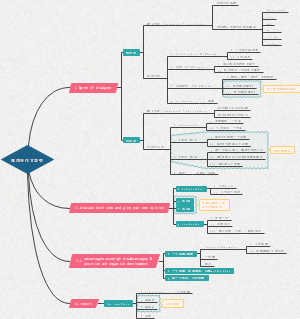导图社区 新编简明英语语言学教程思维导图整本书思维导图
- 1.4k
- 56
- 7
- 举报
新编简明英语语言学教程思维导图整本书思维导图
新编简明英语语言学教程思维导图
编辑于2021-08-10 01:21:45- 相似推荐
- 大纲
A New Concise Course in Linguistics for Students of English 新编简明英语语言学教程
Chapter 1 Introduction
What is language?
Design features of language
arbitrariness
duality
creativity
displacement
cultural transmission
Functions of language
Emotive
Conative
Referential
Poetic
Phatic Communion
Metalinguistic
What is linguistics?
main branches of linguistics (microlinguistics)
phonics语音学
phonology音系学
morphology形态学
snytax句法学
semantics语义学
pragamatics语用学
Macrolinguistics
psycholinguistics心理语言学
sociolinguistics社会语言学
Applied linguistics应用语言学
Important distinctions of linguistics
descriptive VS prescriptive 规定式和描写式
synchronic and diachronic 共时和历时
langue and parole 语言和言语
competence and performance 语言能力语言运用
speech and writng 语言和文字
traditional grammar and modern linguistics传统语法和现代语言学
Chapter 2 Phonology
Phonetics
articulatory phonetics发音语音学
Speech organs
The IPA
Classification
Constants
Vowels
auditory phonetics听觉语音学
acoustic phonetics声觉语音学
Phonology
Phone,Phoneme,Allophone
phonemic contrast, complementary distribution, and minimal pair
Some rules
sequential rules,assimilation rule,deletion rule
Suprasegmentals超音段特征
Stress重音
Intonation语调
Tone声调
Chapter 3 Morphology
Definition of morphology
Identification of words
Classification of words
Open class words and closed class words
Morphemes
Definition
Classification
Analying word structure
Roots
Affixes
Derivational and inflectional morphemes
Morphological rules of word formation
morphological rule
productive morphological rule
Derivation
Compounds
Chapter 4 Syntax
The definition of Syntax
Categories of Syntax
World-level categories
Phrase categories their structures
Phrase structure rule
Definition
XP rule
Coordinates rule
Phrase elements
Specifiers
Complements
Modifiers
Sentences (The S rule)
Transformations
Auxiliary movement
Do insertion
Deep structure and surface structure
Wh movement
Move-α and constraints on transformations
Chapter 5 Semantics
The definition of semantics
some views concerning the study of meaning
The naming theory(Plato)
The conceptualist view(Ogden&Richards)
Contextualism(J.R.Firth)
Behaviourism(Bloomfield)
Lexical meaning
sense and reference
major sense relations
Synonymy
Polysemy
homonymy
hyponyms
Antonymy
Sense relations between sentences
Analysis of meaning
Componential analysis
Prediction analysis
Chapter 6 Pragmatics
Pragmatics & Semantics
Context
Sentense meaning &utterance meaning
speech act theory
Austin's model of speech acts
Searls's classification of speech acts
Indirect speech acts
principals of conversation
Cooperation principals and its Maxims
Violation of the Maxims
Conversational Implicature
Definition
Characteristics of Conversational Implicature
Cross-cultural Pragmatic failure
Chapter 7 Language Change
Definition of historical linguistics
Phonological change
Morphological and syntactic change
Addition of affixes前缀的增加
Loss of affixes词缀的消失
Change of word order词序的改变
Change in negation rule否定规则的变化
Lexical and semantic change
Addition of new words
Loss of words
Semantic changes
some recent trends
Causes of language change
Chapter 8 Language and Society
The scope of sociolinguistics
Defiition of sociolinguistics
The reletedness beween language and society
Speech community and speech variety
Two approach to sociolinguistic studies
Variety of language
Dialectal varieties
Register
Degree of formality
Standard dialect
Pidgin and Creole
Choosing a code
Linguistic taboos and Euphemisms
Chapter 9 Language and Culture
The definition of culture
The relationship between language and culture
Sapir-Whorf Hypothsis
Linguistic evidence of cultural differences
Greeting and terms of stress问候语和称呼语
Gratitude and compliments感激与称赞
Color words颜色词
Privacy and taboos隐私和禁忌
Rounding off numbers数字处理
Words and culture-specific connotations 词及文化特有的内涵
Cultural related idioms,proverbs and metaphor与文化相关的习俗,谚语和隐喻
Cultural contact & Cultural overlap & Cultural diffusion
The significance of cultural teaching and learning
Intercultural communication跨文化交际
Chapter 10 Language Acquisition
Theories of child language acquisition
A behaviour view of language acquisition行为主义者的语言习得观
An innatist view of language acquisition语法天生主义者的语言习得观
An interactionist view of language acquisition互动主义者的语言习得观
Cognitive developments in child development
Language environments and Critical Period Hypothesis语言环境和临界期假说
Stages in child language development
Phonological development音位的发展
Vocabulary development词汇的发展
Grammatical development语法的发展
Pragmatic development语用的发展
Stages in child language development
Atypical developments非典型发展
hearing impairment听力受损
mental retardation思维障碍
autism臆想症
stuttering口吃
aphasia失语症
dyslexia and dysgraphia失读症和书写困难症
Chapter11 Language and Foreign language Teaching
Definition of SLA
Connections and differences between first language acquisition and second language acquisition
Contrastive analysis
Error analysis
Overgeneralization过度概括
Cross-assosiation互相联想
Interlanguage中介语
The role of native language in second language learning
Second language learning models and input hypothesis第二语言的学习模式和输入假说
Individual differences
Language aptitudes
Motivation
Learning strategories
Age of acquisition
Personality
Individual differences
Second language acquisition and its pedagogical implications
Chapter 12 Language and Brain
Neurolinguistics
Definition
The structure and the function of the human brain
Methods in the study of the brain and evidences for lateralization
Aphasia
Psycholinguistics
Definition
Psycholinguistic research methods
Linguistic and language processing
Psycholinguistic modeling









